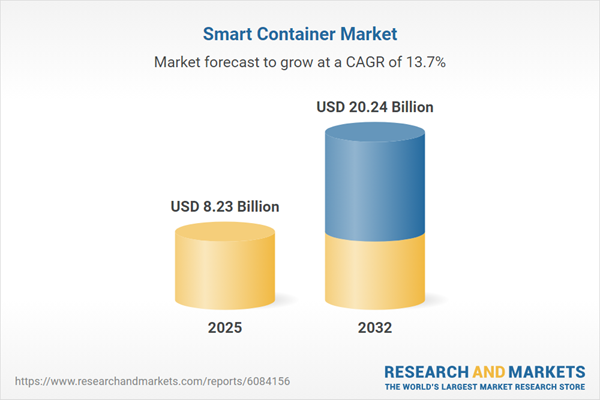Speak directly to the analyst to clarify any post sales queries you may have.
The smart container market is rapidly transforming global supply chains as organizations prioritize connectivity, efficiency, and security. Innovative sensor integration and digital platforms are enabling seamless cargo oversight, driving critical operational shifts in response to modern logistics demands.
Market Snapshot: Smart Container Market Growth Highlights
The Smart Container Market grew from USD 7.23 billion in 2024 to USD 8.23 billion in 2025. The sector is expected to advance at a CAGR of 13.73%, reaching USD 20.24 billion by 2032. This expansion is underpinned by increasingly complex global logistics, rising supply chain pressures, and the widespread adoption of real-time monitoring technologies across industries.
Comprehensive Scope & Segmentation of the Smart Container Market
This report delivers in-depth analysis and forecasts, capturing strategic dimensions across regions, industries, and technologies powering the smart container landscape.
- Container Types: Dry containers, flat rack containers, open top containers, refrigerated containers (including absorption, compressor, and thermoelectric cooling), and tank containers for liquid and bulk transport.
- Material Types: Steel for durability and cost efficiency, aluminum and composite materials for lightweight operation and improved thermal performance.
- Container Sizes: Forty foot equivalent units and twenty foot equivalent units, with options tailored to optimize for long-haul efficiency or last-mile flexibility.
- Technologies: Cloud computing, global navigation satellite systems, Internet of Things (IoT) connectivity (using cellular, LPWAN, satellite, and WiFi), and radio frequency identification across high, low, and ultra-high frequency bands.
- Industries Served: Automotive, chemicals (petrochemicals and specialty chemicals), food and beverage (covering beverages, dairy, fresh produce, and meat), pharmaceuticals (biologics, medicines, and vaccines).
- Applications: Humidity monitoring, location tracking, shock detection, temperature monitoring, and theft prevention.
- Regions Covered: Americas (North America, Latin America), Europe, Middle East & Africa, and Asia-Pacific, with segmentation across key countries and regional supply chain hubs.
- Leading Companies Analyzed: A.P. Moller - Maersk A/S, Mediterranean Shipping Company S.A., CMA CGM S.A., COSCO SHIPPING Lines Co., Ltd., Hapag-Lloyd AG, Evergreen Marine Corporation (Taiwan) Ltd., Ocean Network Express Pte. Ltd., Yang Ming Marine Transport Corporation, Hyundai Merchant Marine Co., Ltd., Orient Overseas Container Line Limited.
Key Takeaways for Senior Supply Chain and Logistics Decision-Makers
- Deploying smart containers enhances cargo transparency, traceability, and environmental control, strengthening risk management for perishable and sensitive goods across sectors.
- Integrating IoT and cloud-based analytics delivers actionable insights, optimizing load planning, routing, dwell times, and supply chain resiliency in both established and emerging trade lanes.
- Lightweight materials such as aluminum and composites support reductions in fuel consumption and carbon emissions, aligning with sustainability mandates and operational efficiency goals.
- The adoption of digital twins, predictive analytics, and advanced sensor networks facilitates real-time operational adjustments, unlocking new business models such as dynamic leasing and service-based logistics.
- Regional strategies adapt to regulatory frameworks and local logistics infrastructure, with Asia-Pacific poised for accelerated adoption through port modernization and e-commerce growth.
- Collaborative approaches—between carriers, technology providers, and integrators—boost service innovation, support next-generation container sharing, and strengthen end-to-end cargo integrity.
Assessing Tariff Impact and Supply Chain Adaptation
Enhanced tariffs in 2025, particularly affecting imported steel containers in the United States, have pushed manufacturers toward alternative materials and nearshoring manufacturing strategies. This trend promotes agility in supply chain sourcing while supporting domestic technology integration and strengthening response to regulatory shifts. Organizations are leveraging real-time analytics for adaptive tariff modeling, supporting proactive inventory and route management across global networks.
Methodology & Data Sources
This analysis applies a rigorous research framework combining qualitative interviews with logistics leaders and leading manufacturers, as well as quantitative examination of industry, regulatory, and academic sources. Data triangulation ensures evidence-based insights, while segmentation is validated by direct engagement with domain specialists and industry experts.
Why This Smart Container Market Report Matters
- Provides strategic intelligence on adopting new technologies, refining supply chains, and complying with evolving regional and global regulations.
- Identifies opportunities for material and operational cost optimization in response to market trends, regulatory tariffs, and demand for sustainable logistics solutions.
- Delivers actionable recommendations for leaders seeking to strengthen resilience and competitive edge through connected cargo management.
Conclusion
Smart containers are redefining supply chain management through technological innovation and adaptive strategies. Executives leveraging the insights within this report are poised to drive resilient growth and unlock new opportunities in increasingly dynamic logistics environments.
Table of Contents
3. Executive Summary
4. Market Overview
7. Cumulative Impact of Artificial Intelligence 2025
Companies Mentioned
The companies profiled in this Smart Container market report include:- A.P. Moller - Maersk A/S
- Mediterranean Shipping Company S.A.
- CMA CGM S.A.
- COSCO SHIPPING Lines Co., Ltd.
- Hapag-Lloyd AG
- Evergreen Marine Corporation (Taiwan) Ltd.
- Ocean Network Express Pte. Ltd.
- Yang Ming Marine Transport Corporation
- Hyundai Merchant Marine Co., Ltd.
- Orient Overseas Container Line Limited
Table Information
| Report Attribute | Details |
|---|---|
| No. of Pages | 195 |
| Published | November 2025 |
| Forecast Period | 2025 - 2032 |
| Estimated Market Value ( USD | $ 8.23 Billion |
| Forecasted Market Value ( USD | $ 20.24 Billion |
| Compound Annual Growth Rate | 13.7% |
| Regions Covered | Global |
| No. of Companies Mentioned | 11 |









